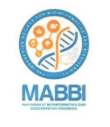MOLECULAR CHARACTERIZATION OF HAP3 GENE IN CASSAVA (Manihot esculenta Crantz)
Abstract
Cassava (Manihot esculenta Crantz) is one of the food crops that has higher resistance to dry land, so it is possible to grow it in dry land. Cassava is used as an alternative food crop to maintain world food security, because the tuber has a high carbohydrate value, is easy to plant and is able to support food diversification. Cassava in Indonesia already has several nationally superior varieties such as Adira 1 and Malang 6. The first stage of cassava breeding is knowing the characteristics of genes in these plants, one of which is HAP3. The purpose of this study was to characterize the HAP3 gene in cassava (Manihot esculenta Crantz) using a molecular approach with genomics and bioinformatics. The methods used were DNA isolation of cassava leaves of Adira 1 and Malang 6 varieties, amplification by PCR, analysis of PCR results, and data sequencing. The results showed that the HAP3 gene in cassava varieties Malang 6 and Adira 1 had 100% homology with cultivar AM560-2 in nucleotide and amino acid sequences. HAP3 cassava varieties Malang 6 and Adira 1 have the closest relationship with Hevea brasiliensis plants with a homology value of 90.91% and Ricinus communis 83.33% based on amino acid sequences. The size of HAP3 on cassava varieties Adira 1 and Malang 6 was 546 bp.
Full Text:
PDFDOI: https://doi.org/10.47007/ijobb.v6i2.136
Refbacks
- There are currently no refbacks.
| Indonesian Journal of Biotechnology and Biodiversity Published by: Publishing Department of Esa Unggul University Arjuna Utara No 9 Street Kebon Jeruk Jakarta - 11510 Indonesia | |








.png)

